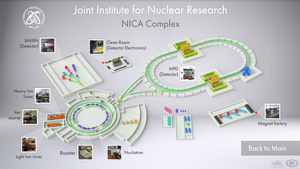The New Projects Hall was created in 2016 and is dedicated to the present and future of JINR.
Here, in particular, a model of the Nuclotron is presented (from the collection of the former JINR Director V.G. Kadyshevsky). The Nuclotron Accelerator was built during the years 1987-1992 in the building of the Synchrophasotron, on the top of the technical floor. The Nuclotron is based on a unique technology of superconducting magnets.
In 2013, the LHEP (formerly LHE) began construction of a proton and heavy ion collider called NICA (the abbreviation: Nuclotron-based Ion Collider fAcility). NICA will be based at the Nuclotron. One of the main tasks of the NICA megaproject is to study the properties of highly compressed baryonic matter. Such matter now exists only in neutron stars and in the supernova nuclei, whereas in the first seconds after the Big Bang, it was it (according to this scientific concept) that prevailed in the Universe. The completion of the NICA collider is planned for 2023. The hall presents the axonometric drawing of the NICA collider, the superconducting magnet used on the collider and the model of the multi-purpose MPD detector made on a 3D printer - one of two detectors that are supposed to be installed on the NICA collider ...
Site, dedicated to the Complex NICA
The exhibits related to the synthesis of transuranium elements are presented here, including models of the U-400 cyclotron and the Factory of superheavy elements. It is noteworthy that all superheavy or transuranic (heavier than uranium) chemical elements discovered in the USSR and Russia were synthesized precisely at JINR - at the Laboratory of Nuclear Reactions.
There are also exhibits illustrating the operation of the six-labaged clinical physical complex of proton and meson therapy (based on the Phazotron - the former Synchrocyclotron) and the Baikal deep-sea neutrino telescope. Two glass detector balls are presented, one of them has been in the thickness of Lake Baikal. The clinic-physical complex operates in the Laboratory of Nuclear Problems, and it also participates in the international Baikal project.

